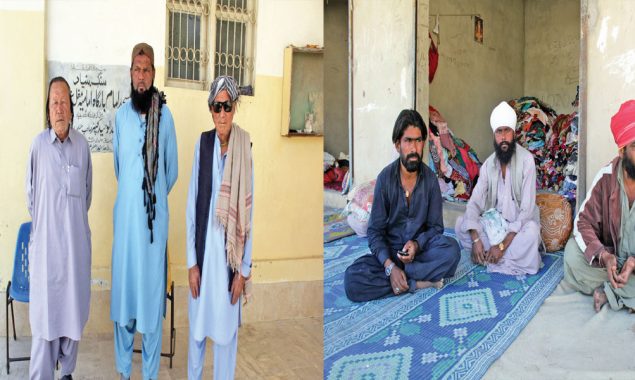Synopsis
Manghopir’s Basti Yaqoob Shah, originally a sanctuary for leprosy patients and their families, is an abode of religious and ethnic harmony

The name Manghopir immediately evokes two images in one’s mind. First of a shrine and pond of crocodiles; the second is of a neighbourhood of Karachi which once was infested with members of the banned Tehreek-i-Taliban Pakistan (TTP). However, there is another side of Manghopir.
This is a tranquil place that is representative of religious, sectarian and ethnic harmony. Paradoxically, a human suffering, leprosy, has been responsible for inculcating this harmony of many dimensions among Manghopir’s populace in general and inhabitants of its neighbourhood Basti Yaqoob Shah in particular.
Two springs that have been gushing hot water for many centuries have been the convergence point.
From olden times the sulphur-rich water of such hot streams is considered as the cure of leprosy. Garam Chashma or hot water spring of Manghopir had started attracting leprosy patients of all castes and creeds from all over the subcontinent in the 18th century.
In 1896, some philanthropists built a yellow sandstone building with Gothic arches, naming it after a Hindu sadhu: Hiranand. Next to the streams thus came into being the first leper hospital in this part of the subcontinent with a dormitory offering free food and residence to anyone who came seeking treatment.
Donors from Hindu, Muslim and Parsi communities kept building the facility thus expanding the neighbourhood. Nearby some donors also built an inn for those who came here for treatment of other skin diseases.
Soon, a mosque and church were also built, catering to the religious obligations of Muslims and Christians.
“Since my childhood I have been seeing mosques and churches standing side by side,” says Sajid Rind, a social activist and sports organiser who lives in a house located only a few yards from the hot water stream.
Sajid added that according to his great grandfather, a triangle-shaped Hindu temple was present there just a hundred yards from the church, before the church and mosques were built there.
The existence of these places of worship in close proximity to each other could also have been an acknowledgement of the mixed populations living in nearby localities since the 13th century when the area’s patron saint Haji Sakhi Sultan — better known as Haji Mangha or Manghopir — had first landed here.
Until the middle of the last century, leprosy patients would come to Hiranand Leper Hospital for good. Nobody left the place alive, mostly due to the social stigmas attached to the disease.
Basti’s background
Their families, too, shifted to the place with them; some relatives of the patients built themselves temporary shelters on hilltops surrounding the facility. Before partition many Uzbek and Hazara from Afghanistan and Balochistan would come here to seek leprosy treatment. Among them was an Uzbek patient, Yaqoob Shah. He never built a house for himself and spent all his life in the hospital but somehow the entire makeshift settlement got named after him — Basti Yaqoob Shah.
“My father would often tell me that Yaqoob Shah used to teach children how to recite the Quran. People from all faiths had respect for him because he was a spiritual man who would offer treatment to their minor ailments through Quranic verses,” said a local.
By the time a German volunteer, Dr Ruth Pfau, came to Karachi in 1960, bringing the treatment of leprosy with her, a few hundred people were already living in those shelters. Soon after her arrival, the hospital properly started treating the leprosy patients.
“At one time it was the only facility in the whole region which today comprises Pakistan and Afghanistan,” says Abdul Salam, a local resident and employee of Marie Adelaide Leprosy Centre. Reportedly, the first inhabitants of the settlement on the hill were a diverse group of people: Hindus, Muslims and Christians from the western parts of British India, Pashtuns from the northwest and Hazaras from Afghanistan.
Salam’s father, Gul Akbar, was one of the first to arrive here after Pakistan had come into being. In 1956, he left his home in what is now Upper Dir district in Khyber Pakhtunkhwa to find a treatment for his leprosy. “When my father arrived, some 30 families were living on the hill. These included Urdu-speaking migrants, Baloch, Kashmiris, Pashtuns, Afghans (mostly Shia Hazara), Hindus and Christians,” Salam further said.
After independence, when Karachi became the first capital of the new country, like elsewhere, this area also saw many developments that helped the neighbourhood expand and turn it into a proper residential area. Manghopir consisted of a few hundred houses mostly around the shrine and Basti Yaqoob Shah started expanding.
A couple of big industrial units set up in the 1960s and ’70s offered much-needed job opportunities to the families of the patients, as well as former patients living on the hill. “At the time Javedan Cement and Dadex were building two factories in Manghopir, providing residents jobs as construction workers,” Sajid explained.
The main reason why people kept coming to the basti, however, remained their search for treatment of leprosy — that is, until a few years ago when the disease’s spread was finally checked.
Kabir, a resident of the neighbourhood, came here as a patient around 1975. His entire family, except his mother, was massacred in Dinajpur in what is now Bangladesh during the 1971 war.
He spent the next two years in a prisoner of war camp in India, before coming to Pakistan and settling down in Sialkot. It was here that Kabir was diagnosed with leprosy. “I’ll never forget that moment,” he said as he recalled his arrival in Basti Yaqoob Shah. “I was 13 years old. My mother woke me up and we disembarked the tonga in front of [the hospital’s] towering archway.”
Babu Lal and his Hindu family, too, have been living in Basti Yaqoob Shah for generations. He works as in-charge of cleaning duties at the hospital.
Read More News On
Catch all the Breaking News Event and Latest News Updates on The BOL News
Download The BOL News App to get the Daily News Update & Follow us on Google News.




